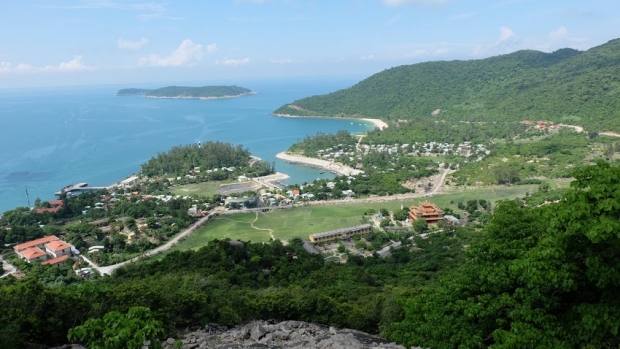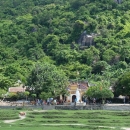Grants :: Small Grant Facilities :: Increase the role and capacity of community in the land use planning process of Pagoda Field, Cu Lao Cham towards sustainable development
Increase the role and capacity of community in the land use planning process of Pagoda Field, Cu Lao Cham towards sustainable development

Pagoda Field Park © Phan Tran Kieu Trang, 2016
Objectives
To contribute to form a mechanism for community’s participating in the planning process and management towards sustainable development and increase the role and capacity of community in the planning process of Pagoda Field, Cu Lao Cham.
Background
Cu Lao Cham is a group of islands within Tan Hiep commune of Hoi An city, Quang Nam province, is the UNESCO recognized Biosphere Resreve. With the soon to be implemented national powerline plan and rapid growth of tourism within this area, the natural and social conditions of Cu Lao Cham Island will be highly impacted. Land use planning for Cu Lao Cham is facing pressure for both tourism activities and conservation effort.
The project aims to improve the planning process of Cu Lao Cham, piloting in Pogoda Field with the community participation. The Pogoda Field covers about 2.7 hectare of land, which was mainly rice field. Due to the shortage of groundwater and the booming of tourism, the Pogoda Field is left abundant. The community participation in the planning process will be documented and will be the case study for the coastal planning regulation.
Target beneficiaries
- Core community groups with at least 20 people with good capacity to represent local people and serve as a connecting bridge between local authority and project team;
- At least 500 people have access to project information and knowledge on planning and project design solution;
- At least 100 people participate in the design planning process;
- Local authorities
Outputs
Deliverables:
- Trainings to communities and local authorities on participation planning process;
- Design planning profile for Pogoda Field area;
- Mobile exhibition in Cu Lao Cham and Hoi An;
- Case study of participatory planning documented
Outputs:
Documents and maps of natural conditions and social assessment reports of Cu Lao Cham serve as basis to help local people have an overall understanding of the current situation and to discuss social issues of the island.
The project completed its objective of creating a connection between local community and government because its outputs address local needs; therefore the project receives high consensus and support from local government from commune to city level.
The training for local people on how to consult community achieved good effects, with the core group works well and help to involve local community. Most of the people agree with prioritized actions within the action framework and show their interest in public design pilot with community’s participation.
Local community actively express their wish to partake in future development issues of Cu Lao Cham and the design of Canh Dong Chua park through consulting meetings, public design sessions and cooperating in designing.
Within all activities the project is always interested in the role and participation of women. Women usually account for a third of the community who join in meetings, tranings and filling in survey forms. Among them, some have actively joined in meetings and trainings, which help to enhance women’s role in community consultation.
Accomplishments and challenges
2.7 ha of Canh Dong Chua area has received the approval from local authority and community to be used as park. Hoi An city spent 12 billion VND to compensate for people and collect this land to build community park, agreed to turn Canh Dong Chua into a public place for community and helped to support tourism in Cu Lao Cham.
The design of Canh Dong Chua has receive high consensus and appreciation from local government and Hoi An CPC has officially announced the approval for Canh Dong Chua park design. The participation of local community in the design of the park has indicated local wish and expectation, which include flexibility and creativity in land use, conservation of native plants, traditional farming practices, connection of culture, green agriculture values, as well as green space for tourism activities.
The initial difficulty when implementing the project is the level of education of community is low and uneven, as many people are illiterate. Therefore many training contents which are represented to community have to be revised to make it less academic and easier to approach community and make them join. The approach and presentation as well as the survey to collect feedbacks from community into the design is also well considerated and selected the most suitable option.
With challenge and pressure from tourism development and land capacity in Cu Lao Cham, the support of local government for this public park model and restoration of traditional farming values has become a strong motivation to encourage the participation of community, when local values and voices of people are listened and their ideas are implemented into real outcomes.
Project sustainability: when people are aware of their roles and have a voice within community they will contribute to the sustainable use and development of local natural resources. Beside that they can also raise their voice to protect environment when needed.
The attitude of community at the beginning of project was not very positive. It takes a lot of time, meetings and surveys to connect local people and get them familiar with project idea, and gradually accept and support project.
This project only works on the design, therefore the next step will need the support from local government to ensure the design will be implemented. Beside that, the implementation should also make sure local participation and suitable experts’ knowledge to turn design into reality. The implementation of this design emphasized the participation of community, conservation of cultural values and green organic farming practices in Hoi An. It needs the close collaboratio between stakeholders, including governmental administration, private sector and local community in Cu Lao Cham.
Contributions to cross-cutting themes
- Climate change: no specific impacts on tackling climate change issues, however the project focused on surveying and researching on the current situation and CC related issues on Cu Lao Cham in general and Canh Dong Chua in particularly to exchange and disperse information.
- Gender equality: The project also regards the gender issue in Cu Lao Cham. Women are encouraged to join in all activities from community consulting, training, situation analysing and collecting surveyed data. An example is that there are 10 women in 21 members of the core group and have positive contribution for project activities. During the process of consultation with local people, women are still passive in giving opinion and leading the discussion section. However, the consultation also explore the appropriate approach to get women’involvement and their opinion and ideas are heard and accepted.
- Potential conflict of interest and/or property possesion and natural resources use rights: the area of Canh Dong Chua is still a sensitive location. Presently part of the area is under use of some local residents, and city council is trying to buy it from them, but the compensation process is not yet finished. In addition to that, Canh Dong Chua is considered as “golden area” in Cu Lao Cham, where many private enterprises want to invest for tourism services while local community and government want to use for park. Therefore the project can be seen as one that has sensitive factors such as local conflicts in regards of land use rights and property possession rights. However, up to present, the project has received high consensus from local government and community in supporting local community to express their common vision of Cu Lao Cham and partake in designing of Canh Dong Chua park on the island.
Lessons Learned
Need to thoroughly check local people’s level of education prior to project implementation to use suitable approach. For example, illiterate people on the island are unable to join the survey and fill in forms like higher educated group. This challenge is solved in the following meetings when academice questions and indicators are replaced by direct interviews and group discussion for people to join more easily.
Since the core groups were formed, other tasks such as organizing meetings and calling for people’s support have become easier as the encouragement from this group can persuade people better. This is a success of project. The participation of local community gradually become much higher for other activities, which proves that the project have become more effective and familiar with local people.
Local community understand about their living area and their expectations, therefore their feedback is helpful for the project. Community’s feedback is discussed and used, in which local cultural factor is conserved and maintained.
Project Facts
Country
Location
Hon Lao, main island of Cu Lao Cham, Tan Hiep commune, Hoi An city
Topic
- Capacity Building
- Capacity development
- Civil Society Engagement
- Community Resilence
- Sustainable Livelihoods
Duration
1st Mar 2016 to 1st Mar 2017
MFF Grant Amount
VND 276,580,000
Co-financing Partner
Da Nang Architecture University
VND 313,450,000
Implementing Partner
Da Nang Architecture University
Address: 566 Nui Thanh, Hai Chau dist, Da Nang
Ms Phan Tran Kieu Trang
